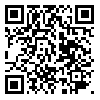Volume 5, Issue 4 (15 2013)
ijhe 2013, 5(4): 497-508 |
Back to browse issues page
Download citation:
BibTeX | RIS | EndNote | Medlars | ProCite | Reference Manager | RefWorks
Send citation to:



BibTeX | RIS | EndNote | Medlars | ProCite | Reference Manager | RefWorks
Send citation to:
Mohammadi A S, Sardar M. The Removal of Penicillin G from Aqueous Solutions using Chestnut Shell Modified with H2SO4: Isotherm and Kinetic Study. ijhe 2013; 5 (4) :497-508
URL: http://ijhe.tums.ac.ir/article-1-8-en.html
URL: http://ijhe.tums.ac.ir/article-1-8-en.html
1- , mahdiehsardar@yahoo.com
Abstract: (12295 Views)
MicrosoftInternetExplorer4 Background
and Objectives: Antibiotics are
potential pollutants that represent an important environmental problem because
of their toxic effects on the food chain and aqueous streams. The objective of
this research was to study the adsorption of penicillin G on to chestnut shell
as an inexpensive adsorbent.
Materials and Methods: This study was performed at laboratory scale and batch system. We studied the influence of process variables such as adsorbent dose, initial PEN G concentration, pH of solution, contact time, and breakthrough curves. In order to find out the possibility of reuse, desorption study was also carried out. The surface characteristics of adsorbent were investigated using Fourier Transform Infra-Red and Scanning electron microscope. Equilibrium study data were modeled using Langmuir, Freundlich, and D-R models. Moreover, kinetic studies were done by three models of pseudo first order, pseudo second order, and intra-particle diffusion.
Resuls: The maximum PEN G removal achieved was 92%, at pH 3, adsorbent dose 0.1 g/l and contact time 120 min. The Langmuir equation (R2=0.99) provided the best fit for the experimental data. It was also found that adsorption of PEN G by chestnut shell followed pseudo- second order model (R2= 0.992).
Conclusion: According to the results obtained, chestnut shell appears to be a suitable, low cost and efficient adsorbent for removing PEN G from waste streams.
Materials and Methods: This study was performed at laboratory scale and batch system. We studied the influence of process variables such as adsorbent dose, initial PEN G concentration, pH of solution, contact time, and breakthrough curves. In order to find out the possibility of reuse, desorption study was also carried out. The surface characteristics of adsorbent were investigated using Fourier Transform Infra-Red and Scanning electron microscope. Equilibrium study data were modeled using Langmuir, Freundlich, and D-R models. Moreover, kinetic studies were done by three models of pseudo first order, pseudo second order, and intra-particle diffusion.
Resuls: The maximum PEN G removal achieved was 92%, at pH 3, adsorbent dose 0.1 g/l and contact time 120 min. The Langmuir equation (R2=0.99) provided the best fit for the experimental data. It was also found that adsorption of PEN G by chestnut shell followed pseudo- second order model (R2= 0.992).
Conclusion: According to the results obtained, chestnut shell appears to be a suitable, low cost and efficient adsorbent for removing PEN G from waste streams.
Type of Study: Research |
Subject:
General
Received: 2012/04/22 | Accepted: 2012/07/22 | Published: 2013/07/13
Received: 2012/04/22 | Accepted: 2012/07/22 | Published: 2013/07/13
Send email to the article author
| Rights and Permissions | |
 |
This work is licensed under a Creative Commons Attribution-NonCommercial 4.0 International License. |





